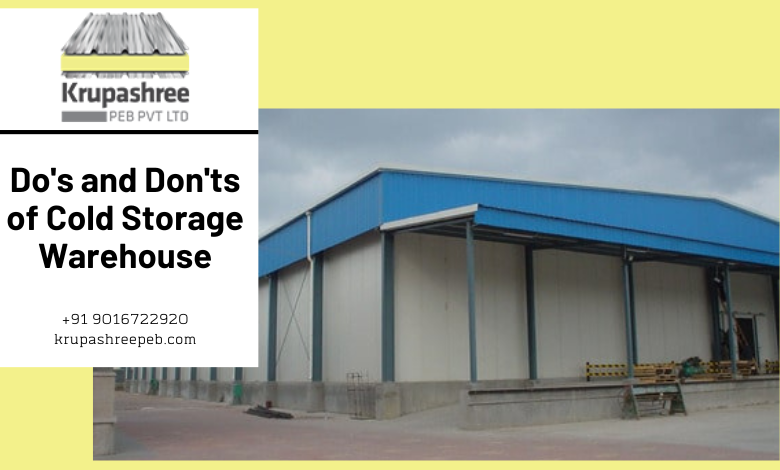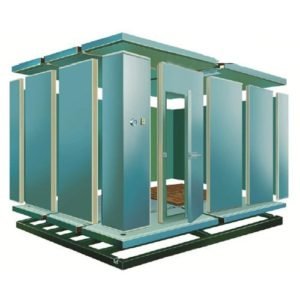Do’s and Don’ts of Cold Storage Warehouse

A cold storage warehouse is an architectural box that protects refrigerated and frozen commodities. It consists of a roof, walls, and a floor slab at its basic level.
Designing a cold storage warehouse is a complex task with close attention to detail and a collaborative design team knowledgeable about cold storage best practices. You can save a client time, money, energy, and unnecessary hurdles in the long run.
Here are some do’s and don’ts of the cold storage warehouse.
The Do’s
-
Measure Airflow, Humidity, and Temperature
 Understanding how air moves and how moisture and heat are transmitted throughout a cold storage envelope is critical. It’s essential to carefully construct entries into cold storage facilities with doors that seal tightly, strips that stop airflow, and intermediate temperature rooms that act as air locks to limit the movement of cold and hot air.
Understanding how air moves and how moisture and heat are transmitted throughout a cold storage envelope is critical. It’s essential to carefully construct entries into cold storage facilities with doors that seal tightly, strips that stop airflow, and intermediate temperature rooms that act as air locks to limit the movement of cold and hot air.Understanding moisture is likely the most challenging aspect of building design. Cold air’s moisture capacity is lower than that of warm air. It cannot hold the moisture in the air once it enters the chilly environment, so it condenses into water; as the temperature falls below 32°F, frost and ice form.
The common thread that influences air density and humidity is temperature. Successful cold storage solutions require effective sealing and insulation of the building envelope to maintain a continuous vapor barrier and prevent heat transmission.
-
Know what temperature you’re working with
Building a 40°F cold storage warehouse that can handle a cooler differs from designing for a -32°F freezer warehouse since particular considerations must be made to deal with ice. In cold storage warehouse (-32°F freezer), ice buildup is near the openings and machinery. Below are a few do’s to consider while building cold storage.
-
- Place a heavy-duty vapor barrier on a freezer slab.
- Ensure that freezer slabs are insulated. To prevent temperature transmission, the layer should have staggered connections at both the slab and roof.
- Check your glycol system for holes or punctures in the piping before pouring concrete.
- Make sure the heating system has redundant loops. Even if one of the loops fails, the slab will protect you.
-
Collaborate
It’s essential to work with your mechanical engineer to determine the proper panel thickness—for the floor, walls, and roof of the building envelope to strike a balance between insulation and energy costs. You need to consult with your refrigeration design professionals to determine the best refrigeration system for your needs.
-
Consider the insulation and the terminations of the envelope
It is recommended to employ insulated metal panels (IMPs) for the building envelope and continuous insulation at all transitions, which necessitates the installation of thermal breaks at the changes between the slab, wall, and roof insulation.
-
Recognize the impact of temperature
Understanding building materials and how temperature affects them is critical. When metal enters a room with various temperatures, it transfers the temperature. For example, a steel beam will transport cold to warm. Galvanizing structural steel is a must. Without this protection, the steel will rust over time due to exposure to the elements.
-
Recognize how the racking and retrieval system works
Today’s vast warehouses automate cold storage facility racking and retrieval systems with cranes and retrieval components. As a result, it’s critical to understand how the facility’s owner plans to use the racking and retrieval system, as the most efficient design can differ depending on the client’s needs.
-
Foam-in-place insulation is a good option
It can be challenging to obtain board insulation that fits the “nooks and crannies” when you make the various transitions. To maintain a continuous thermal envelope, cold storage manufacturers in India employ foam-in-place insulation at transitions between the wall and the roof.
A Few Don’ts to Remember
-
- Consider heat transfer while constructing near an existing freezer or cold storage. Consider heat transmission from nearby structures for various floor heights. For vertical transitions, such as concrete stem walls, heat trace or glycol warming may be required.
- One thing you don’t want to do with roof insulation fasteners is causing thermal bridging. Specify stainless-steel fasteners to reduce the danger of corrosion if you’re working in an area where fastening through the insulation is required due to wind uplift.
- Avoid parapet situations at cold storage regions owing to heat transfer because you don’t need to get too creative with architectural features for a cold storage facility. Call a cold storage supplier in India, and keep transitions and terminations of insulation, vapor barriers, and panels basic and tidy for easy installation.
You may also like this amazing blog on Commercial Transformer.
Conclusion
The design company that understands the do’s and don’ts of cold storage facility design has the knowledge and experience to pay attention to even the tiniest of details, allowing clients to concentrate entirely on their logistics for successful delivery to the marketplace.








